Key Points
- 50,000 species of fish exist and more are being discovered every year.
- More than 41% of fish species live in freshwater.
- The Great Lakes are popular for angling, with 15 excitingly large fish species to catch there.
As far as we know, fish make up more than half of all vertebrates in the world. Today, there are about 50,000 types that we know about, and new fish species are being discovered every year. More than 41% of the world’s fish population can be found in freshwater.
Many of us may not know that only about 1% of the world’s water from freshwater rivers and lakes is available to us. The Great Lakes in North America hold 21% of the world’s freshwater supply! Every season, people fish in the Great Lakes. For anglers, there are a lot of fish to choose from, about 160 species. To help you on your next Great Lake fishing adventure, we narrowed down the best catches to the 15 biggest fish you can find in these waters!

Where are the Great Lakes?
The Great Lakes are a chain of five lakes located in the northern part of North America. The five lakes are Lake Superior, Lake Michigan, Lake Huron, Lake Erie and Lake Ontario. These five large freshwater lakes form the largest group of freshwater lakes on Earth and contain approximately 20% of the world’s fresh surface water supply.
They span across eight US states (Minnesota, Wisconsin, Illinois, Indiana, Michigan, Ohio, Pennsylvania New York) and two Canadian provinces (Ontario and Quebec).
They are all connected by several rivers such as the St Clair River, which connects Lake Huron to Lake Saint Clair. And the Detroit River, which connects Lake Erie to Lake Saint Clair. These rivers help regulate levels between these massive bodies of water and facilitate an exchange of species between them. The Great Lakes watershed is home to over 35 million people, making it one of the most densely populated regions in North America. It is also important economically as it provides fresh drinking water for many cities as well as being a major shipping route for goods from around the world.
The 15 Biggest Fish In The Great Lakes
15. Pink Salmon – 4.8 lbs
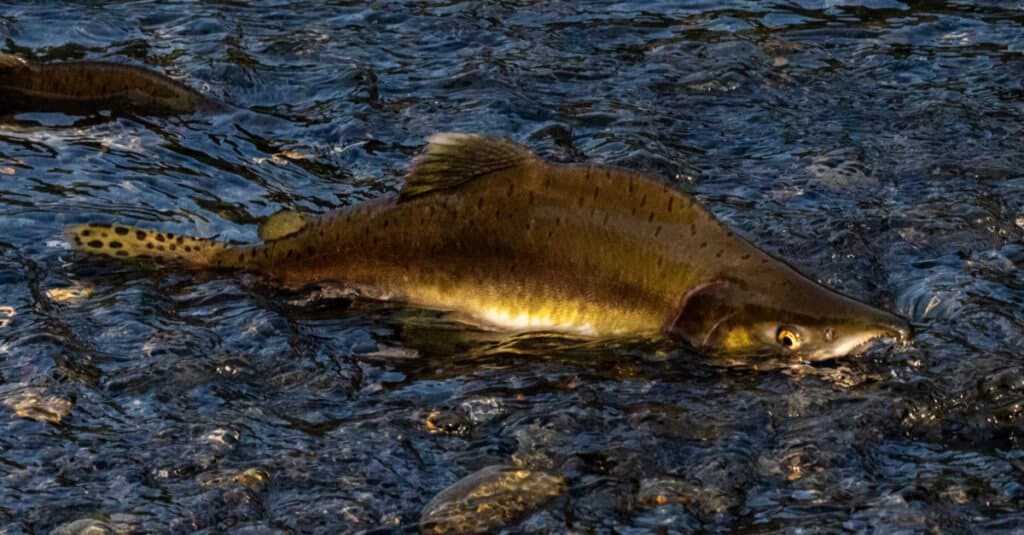
The smallest salmon species in the Great Lakes is the pink salmon.
©Mark A. McCaffrey/Shutterstock.com
The pink salmon is the smallest salmon species inhabiting the Great Lakes, weighing 4.8 lbs on average. However, despite being the tiniest of its type, it is one of the largest fish species among the other marine life in the North American Great Lakes. There are now self-sustaining populations of pink salmon in the Great Lakes after being introduced to the continent’s biggest freshwater system. Yet, pink salmon have originated from the Pacific and Arctic coastal rivers and prefer to live in cold water. The largest pink salmon ever caught weighed 15 lbs.
14. Brook Trout – 6 to 7 lbs, can grow to 15 lbs
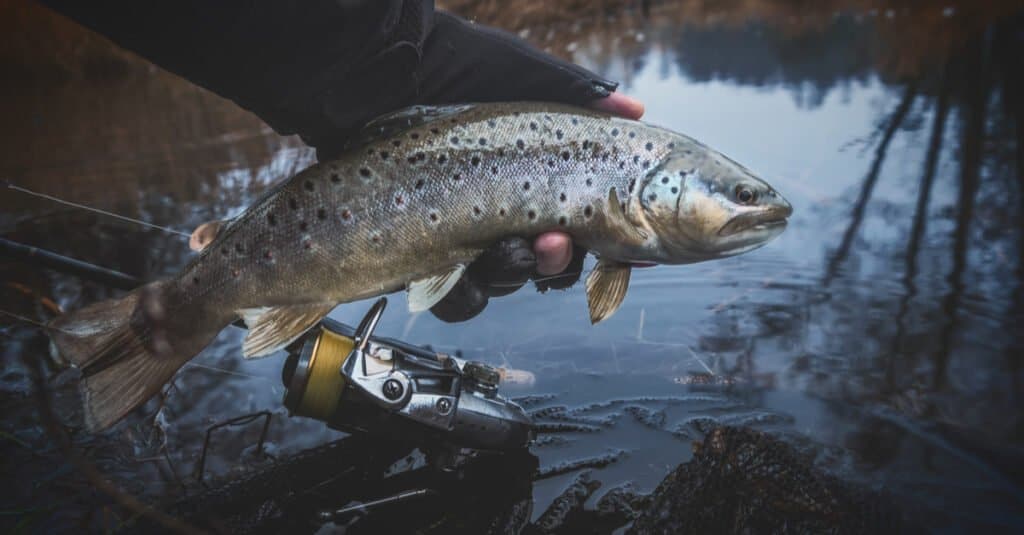
A brook trout typically weighs 6 pounds and can weigh as much as 15 pounds.
©wwwarjag/Shutterstock.com
The brook trout, commonly known as the speckled trout, is a fascinating fish with remarkable yellow spots on an olive-green back. The freshwater fish’s color changes from olive to orange or red down its flanks, with dispersed red spots rimmed by pale blue. A brook trout typically weighs 6 lbs and measures 9.8 inches long. The brook trout is Michigan’s state fish since it is native to the state’s lakes.
13. Atlantic Salmon – 8 to 12 lbs
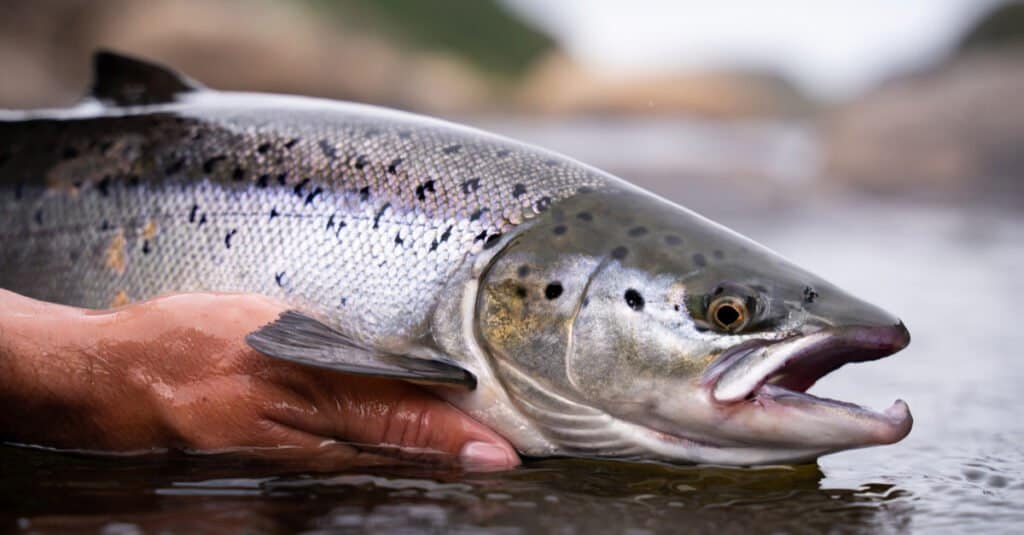
The third-largest Salmonidae species is the Atlantic salmon.
©Ilya Marchenko/Shutterstock.com
The Atlantic salmon is a ray-finned fish belonging to the Salmonidae family. It is the third-largest Salmonidae species, behind Siberian Taimen and Pacific Chinook Salmon, with a length of 28 to 30 inches and a weight of up to 12 lbs (5.4 kg). Rivers in Europe and the northeastern coast of North America are natural breeding areas for Atlantic salmon. Changes in freshwater environments and climate significantly impact this species’ distribution.
12. Largemouth Bass – 12 lbs
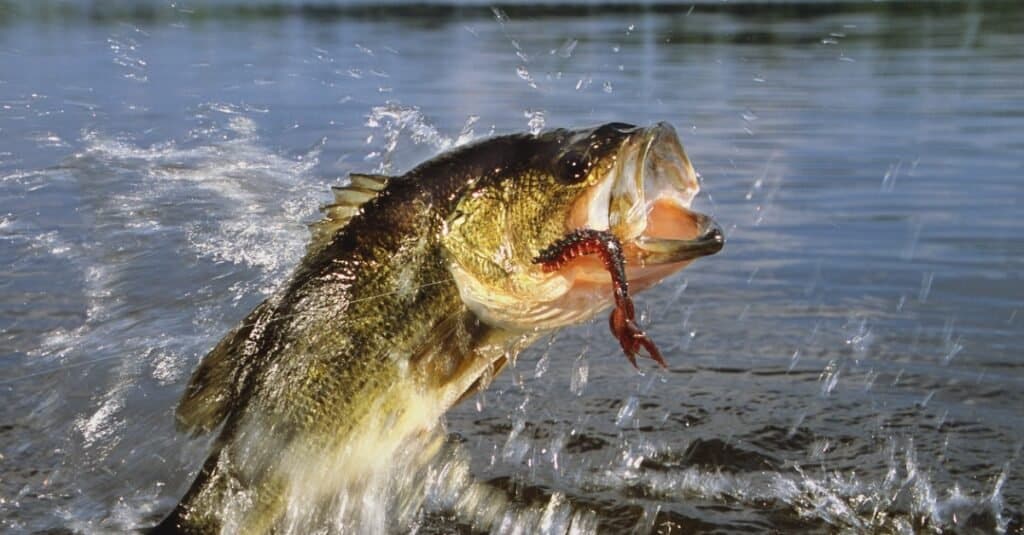
One of the most common species to catch in the United States is the largemouth bass.
©iStock.com/stammphoto
Largemouth bass is one of the most common species to catch in the United States, and for a good reason. This green fish can develop quite large, especially in the Great Lakes of North America. Largemouth bass typically grow 12.12 pounds (5.5 kg) and 4 to 8 inches in their first year, up to 14 inches in their second year, and up to 18 inches or more in their third year. The largest largemouth caught weighed 22 pounds.
11. Coho Salmon – 18.5 lbs

Coho salmon eat small fish, including anchovies, herring, and sardines.
©Keith Publicover/Shutterstock.com
Weighing about 18.52 lbs or 8.4 kg, the coho salmon is another huge salmon species that is considered a good catch in the Great Lakes or any other lake. The coho salmon is not endemic to the Great Lakes, but after effective distribution efforts in Lake Michigan in the mid-1960s, it has expanded fast. Originally stocked to exploit and control alewife numbers, the states touching the Great Lakes and the Canadian province of Ontario have continued to supply this species as a profitable sport fish. When they’re in the ocean, they eat small fish, including anchovies, herring, and sardines.
10. Lake Whitefish – 22 lbs

Weighing around 22 lbs, lake whitefish is one of the largest in the Great Lakes.
©Natalya Osipova/Shutterstock.com
Lake whitefish is another heavy fish caught in the Great Lakes, weighing around 22 lbs or 10 kg. Noted as the major commercial fish in Lakes Ontario and Huron, the captures from these two lakes have totaled more than $5 million in a single year. Whitefish is also an essential part of the commercial fisheries in Lake Michigan and a sought-after sport fish throughout the Great Lakes.
9. Walleye – 24 lbs

The walleye is the largest member of the perch family.
©FedBul/Shutterstock.com
The perch family’s largest member is the walleye, weighing 24.25 lbs or 11 kg. These struggling fish are fun to catch, tasty to eat, and provide a great year-round sport fishery as they feed vigorously throughout winter. In the spring, walleyes swarm in low bay waters, looking for rocky outcroppings and underwater bars.
8. Brown Trout- 26 lbs
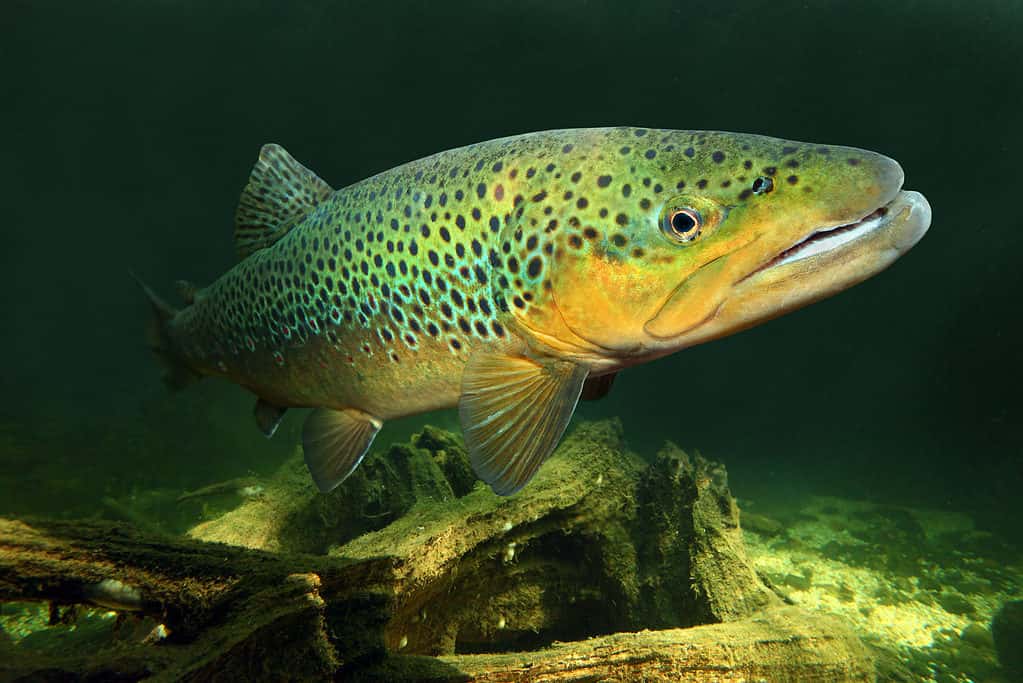
Although adults average 26.45 pounds, some brown trout can weigh 53 pounds.
©iStock.com/abadonian
Brown trout were perhaps the first salmonid species to be imported to the Great Lakes, and they may now be found in all of them. They can be identified by the light-ringed black dots on their brown body, present in many other parts of the world. Adult brown trout average approximately 26.45 pounds (12 kilograms), but some specimens can weigh 53 pounds (24 kilograms).
7. Rainbow Trout- 26.45 lbs
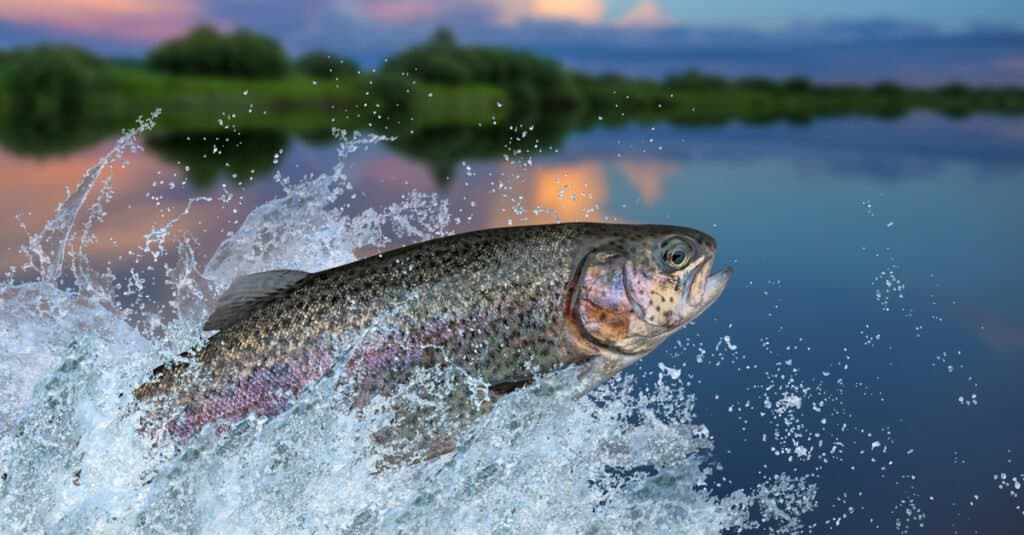
Rainbow trout weigh 26.45 lbs.
©FedBul/Shutterstock.com
The names “rainbow trout” and “steelhead salmon” pertain to the same fish. However, their habits vary based on where they were born (or stocked). It is another Pacific coast species that has been successfully introduced to all of the Great Lakes. The rainbow trout weighs 26.45 lbs or 12 kg, just like the brown trout, and ranks as one of the biggest fish inhabiting the Great Lakes. It spends most of its time at sea or lakes before migrating to rivers and streams in the spring to breed.
6. Chinook Salmon – 30.86 lbs
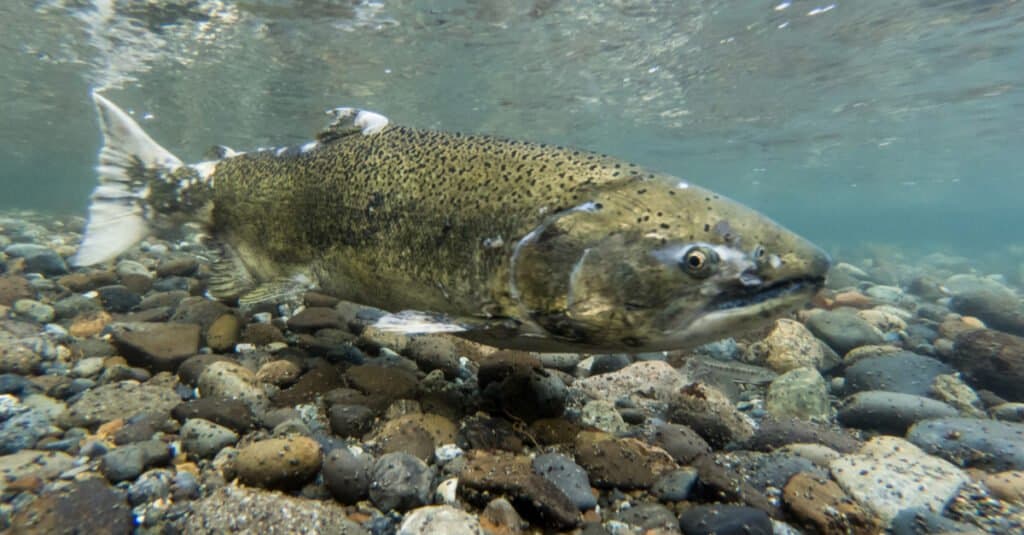
The Chinook salmon is the largest among the Pacific salmon.
©Kevin Cass/Shutterstock.com
Chinook salmon, which originated on the Pacific and Arctic coasts, was brought to all of the Great Lakes. This salmon species is the largest among the Pacific salmon, reaching 35 inches (90 cm) in length and weighing 30.86 pounds (14 kg). While salmon populations in the Great Lakes have had a shaky past, permanent coho and chinook numbers were developed during the mid and late 1960s, when over 20 million were supplied.
5. Lake Trout – 39.68 lbs

The fifth-largest fish in the Great Lakes is the Lake Trout.
©iStock.com/VvoeVale
Lake trout have returned to the Great Lakes after being virtually wiped out by commercial fisheries in the mid-19th century and succumbing to parasitic sea lamprey. This large fish prefers to swim in cooler, deeper waters and can grow up to 39.48 lbs or 18 kg. Natural reproduction has aided the activities of fisheries managers in some areas, with stocking programs in all five lakes bringing the once-popular native species back. This natural deepwater predator has long been a popular target for commercial and recreational anglers.
4. Burbot – 41.89 lbs
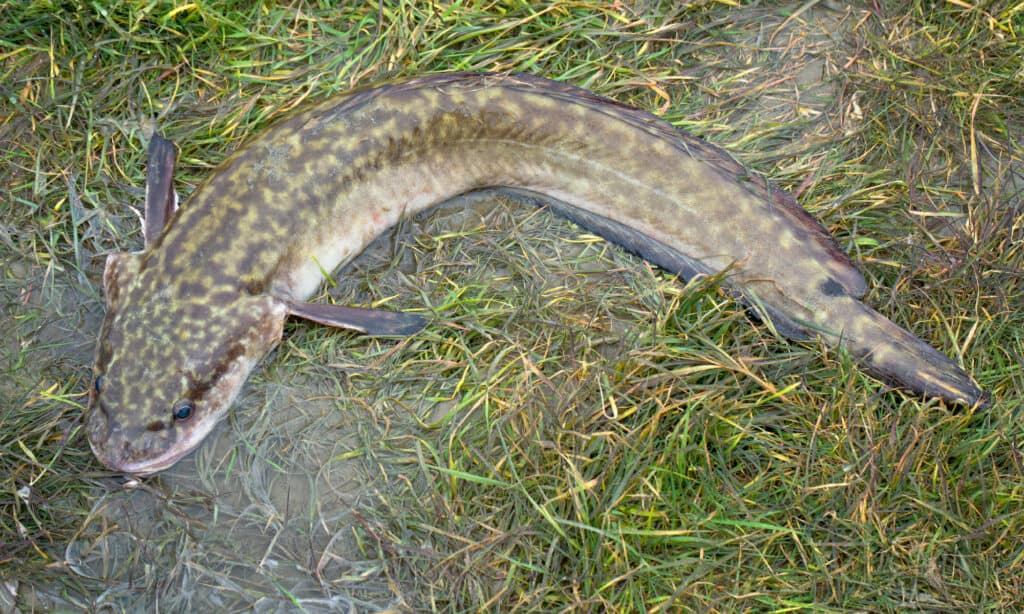
The burbot looks like a cod.
©iStock.com/Krugloff
Burbots are slow-moving fish that weigh up to 41.89 lbs or 19 kg. This species prefers to lurk in dark regions around shipwrecks, especially deeper ones. The burbot is a freshwater fish that looks like a cod. Although they are rarely eaten, they are edible fish catch because most anglers think they look too “eel-like.”
3. Channel Catfish – 39.68 to 50.71 lbs

Channel catfish can be found in all Great Lakes apart from Lake Superior.
©Sergey Goruppa/Shutterstock.com
The channel catfish is a type of catfish for consumption despite being a bottom feeder. The channel catfish is one of the most interesting Great Lakes residents and weighs 39.68 to 50.71 lbs or 18 to 23 kg. This fish species has been found in North America for about 3,000 years. Except for Lake Superior, they can now be found in all of the Great Lakes. The body of a channel catfish is cylindrical in cross-section and devoid of scales.
2. Musky or Muskellunge – 70.10 lbs
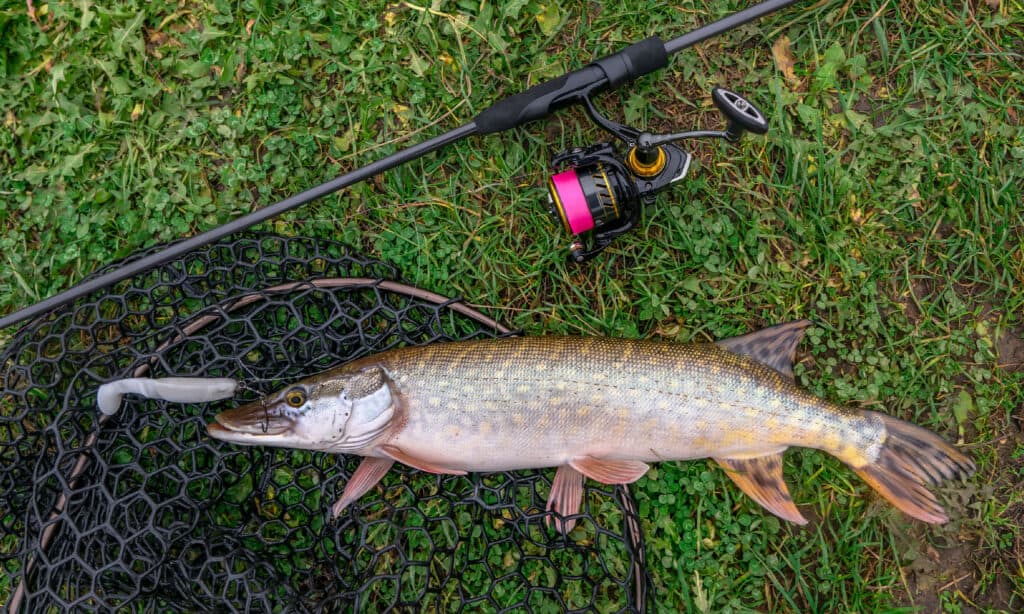
After sturgeon, muskies are the second-largest fish in the Great Lakes.
©iStock.com/FedBul
Muskies are the second-largest fish in the Great Lakes, after sturgeons. The average adult typically measures 28-48 inches (0.7-1.2 m) in length and weighs 5-36 pounds (2-16kg). However, some muskies can grow even beyond that, reaching a maximum weight of 70.10 lbs. The muskellunge is noted for its little barracuda teeth and is a dangerous game fish. Sometimes known as the muskie, the muskellunge is a very effective “predator machine.” It hides in the shadows of vegetation or sunken logs along the coast, only emerging to strike a target fish.
1. Lake Sturgeon – 198.42 lbs

The lake sturgeon is the biggest Great Lake Fish.
©Fabien Monteil/Shutterstock.com
Weighing almost 200 pounds or 90 kilograms, the lake sturgeon is undoubtedly the biggest Great Lake fish. Apart from being a prized catch for its notable mass, the lake sturgeon is also the source of the expensive caviar. Despite their name, lake sturgeon can be found in both rivers and lakes. The fish’s range extends from Hudson Bay to the Mississippi River in North America. This fish was originally a common species in the Great Lakes ecosystems, but overfishing has reduced its population. Small invertebrates, including crayfish, snails, clams, and leeches, are consumed by lake sturgeon around the lake’s bottom.
Summary: Largest fish in the Great Lakes
| Rank | Species |
|---|---|
| 1 | Lake Sturgeon |
| 2 | Musky |
| 3 | Channel Catfish |
| 4 | Burbot |
| 5 | Lake Trout |
| 6 | Chinook Salmon |
| 7 | Rainbow Trout |
| 8 | Brown Trout |
| 9 | Walleye |
| 10 | Lake Whitefish |
| 11 | Coho Salmon |
| 12 | Largemouth Bass |
| 13 | Atlantic Salmon |
| 14 | Brook Trout |
| 15 | Pink Salmon |
Honorable Mentions: Biggest Fish In The Great Lakes

There is a small population of Beluga Whales that live in the St. Lawerence River.
©Marco De Luca/Shutterstock.com
While we have a fantastic list already over 15 of the Biggest Fish in the Great Lakes, we decided to include a few more.
Here are a few other bonus species of fish you can find in the great lakes that didn’t make our list:
One interesterting fact about the Great Lakes is that there is a small population of Beluga Whales that live in the St. Lawrence River. This river and waterway is super important for the Great Lakes because it connects them to the Atlantic Ocean and allows big ships to travel through the area. The river is about 800 miles long.
Bluegills come in various sizes, typically spanning from seven to 15 inches. However, most bluegills you’ll find between four to six inches and weigh half a pound or less. In general, males tend to be bigger than females. The largest recorded bluegill in the United States was caught in Alabama in 1950, weighing four pounds and 12 ounces, with a length of 15 inches.
While mostly white perch stay rather small. There have been records of white perch growing up to 19 inches when fully mature, but they are typically seen at sizes ranging from seven to 10 inches, and they weigh between eight ounces and one pound.
The photo featured at the top of this post is ©
Thank you for reading! Have some feedback for us? Contact the AZ Animals editorial team.






